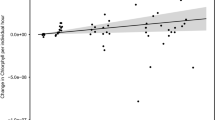Abstract
The occurrence of six littoral species of Ceriodaphnia (C. affinis, C. laticaudata, C. megops,C. reticulata, C. rotunda and C. setosa)living at the same time and locality is described.Basic population characteristics were studied in allspecies coexisting in the field, except for C. setosa, which was too scarce. Abundances,proportions of gamogenetic individuals, mean bodylengths and clutch sizes were compared among species.Dissolved oxygen, temperature, chlorophyll-a and totalseston volume were measured and related to populationchanges. C. laticaudata and C. rotundawere closely similar to each other in many featuresand showed significant differences to other species.C. reticulata and C. megops seem to besimilar in some features, while C. affinis wasecologically different.
Similar content being viewed by others
References
Anderson, D. H. & A. C. Benke, 1994. Growth and reproduction of the cladoceran Ceriodaphnia dubiafrom a forested floodplain swamp. Limnol. Oceanogr. 39: 1517–1527.
Boersma, M. & J. Vijverberg, 1996. Food effects on life history traits and seasonal dynamics of Ceriodaphnia pulchella. Freshwat. Biol. 35: 25–34.
Burgis, M. J., 1967. A quantitative study of reproduction in some species of Ceriodaphnia(Crustacea: Cladocera). J. anim. Ecol. 36: 61–75.
Chengalath, R., 1982. A faunistic and ecological survey of the littoral Cladocera of Canada. Can. J. Zool. 60: 2668–2682.
Cowgill, U. M., K. I. Keating & I. T. Takahashi, 1985. Fecundity and longevity of Ceriodaphnia dubia/affinisin relation to diet at different temperatures. J. Crust. Biol. 5: 420–429.
Forsyth, D. J. & M. R. James, 1984. Zooplankton grazing on lake bacterioplankton and phytoplankton. J. Plankton Res. 6: 803–810.
Gophen, M., 1976. Temperature dependence of food intake, ammonia excretion and respiration in Ceriodaphnia reticulata(Jurine) (Lake Kinneret, Israel). Freshwat. Biol. 6: 451–455.
Gophen, M., B. Z. Cavari & T. Berman, 1974. Zooplankton feeding on differentially labelled algae and bacteria. Nature 247: 393–340.
Hanazato, T., S. I. Dodson, 1995. Synergistic effects of low oxygen concentration, predator kairomone, and a pesticide on the cladoceran Daphnia pulex. Limnol. Oceanogr. 40: 700–709.
Hensiek, W., 1955. Das Vorkommen der Cladoceren im Dümmer im Sommer 1952. Arch. Hydrobiol. 50: 160–187.
Hořická, Z., 1983. Reaction of the population of Daphnia pulicaria and Daphnia galeata(Cladocera) on the changes of seston concentration within spring period. Msc. Thesis, Faculty of Science, Charles University, Prague: 119 pp (in Czech).
Hudec, I., 1993. Notes to the distribution of the genus Ceriodaphnia (Crustacea: Anomopoda, Daphniidae) in Slovakia. 1st part: C. reticulata, C. affinis, C. megops. Biológia Bratislava 48: 485–491.
Kamiński, K., 1979. Ceriodaphnia setosaMatile, 1890 (Cladocera)–rarely observed species in Poland. Przegl. Zool. 23: 41–44 (in Polish).
Lim, R. P., 1976. Community description, population dynamics and production of Cladocera with special reference to the littoral region of Pinehurst lake, Ontario. PhD. Thesis, University of Waterloo: 350 pp.
Nováková, J., 1976. Development and growth of three species of the genus Ceriodaphnia. Rigor. Thesis. Faculty of Science, Charles University, Prague, 46 pp (in Czech).
O’Brien, J. W., 1974. Filtering rate of Ceriodaphnia reticulatain pond waters of varying phytoplankton concentrations. Am. Midl. Nat. 91: 209–512.
Rodriguez, V., F. Echevarria & B. Bautista, 1991. In situ diel variation in gut pigments of Ceriodaphniasp. in stratification and destratification periods. J. Plankton Res. 13: 187–196.
Schoenberg, S. A., 1989. Effects of algal concentration, bacterial size and water chemistry on the ingestion of natural bacteria by cladocerans. J. Plankton Res. 11: 1273–1295.
Shuba, T. & R. R. Costa, 1972. Development and growth of Ceriodaphnia reticulataembryos. Trans. am. Microsc. Soc. 91: 429–435.
Šrámek-Hušek, R., 1962. Fauna ČSSR. Lupenonožci-Branchiopoda, Sv. 16, ČSAV, Prague, 470 pp (in Czech).
Straškraba, M., 1963. Share of the littoral region in the productivity of two fishponds in Southern Bohemia. Rozpravy ČSAV, MPV 73, 13, 64 pp.
Zar, J. H., 1984. Biostatistical analysis. 2nd edn. Prentice-Hall, Englewood Cliffs, N.J. 718 pp.
Author information
Authors and Affiliations
Rights and permissions
About this article
Cite this article
Pichlová, R. Ecological similarities and differences among littoral species of Ceriodaphnia. Hydrobiologia 360, 205–210 (1997). https://doi.org/10.1023/A:1003133823119
Issue Date:
DOI: https://doi.org/10.1023/A:1003133823119



